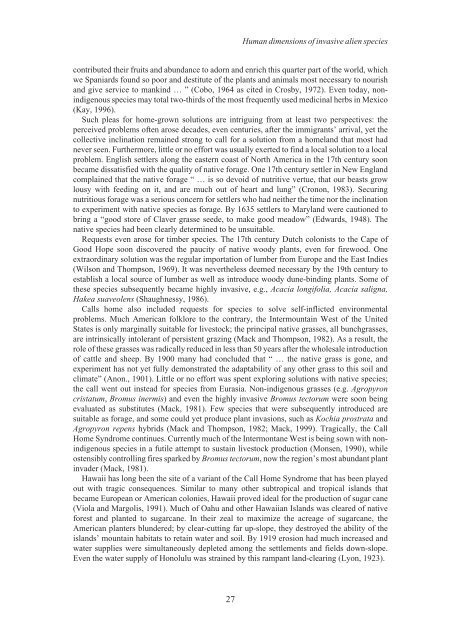Alien Species.vp - IUCN
Alien Species.vp - IUCN
Alien Species.vp - IUCN
You also want an ePaper? Increase the reach of your titles
YUMPU automatically turns print PDFs into web optimized ePapers that Google loves.
contributed their fruits and abundance to adorn and enrich this quarter part of the world, which<br />
we Spaniards found so poor and destitute of the plants and animals most necessary to nourish<br />
and give service to mankind … ” (Cobo, 1964 as cited in Crosby, 1972). Even today, nonindigenous<br />
species may total two-thirds of the most frequently used medicinal herbs in Mexico<br />
(Kay, 1996).<br />
Such pleas for home-grown solutions are intriguing from at least two perspectives: the<br />
perceived problems often arose decades, even centuries, after the immigrants’ arrival, yet the<br />
collective inclination remained strong to call for a solution from a homeland that most had<br />
never seen. Furthermore, little or no effort was usually exerted to find a local solution to a local<br />
problem. English settlers along the eastern coast of North America in the 17th century soon<br />
became dissatisfied with the quality of native forage. One 17th century settler in New England<br />
complained that the native forage “…issodevoid of nutritive vertue, that our beasts grow<br />
lousy with feeding on it, and are much out of heart and lung” (Cronon, 1983). Securing<br />
nutritious forage was a serious concern for settlers who had neither the time nor the inclination<br />
to experiment with native species as forage. By 1635 settlers to Maryland were cautioned to<br />
bring a “good store of Claver grasse seede, to make good meadow” (Edwards, 1948). The<br />
native species had been clearly determined to be unsuitable.<br />
Requests even arose for timber species. The 17th century Dutch colonists to the Cape of<br />
Good Hope soon discovered the paucity of native woody plants, even for firewood. One<br />
extraordinary solution was the regular importation of lumber from Europe and the East Indies<br />
(Wilson and Thompson, 1969). It was nevertheless deemed necessary by the 19th century to<br />
establish a local source of lumber as well as introduce woody dune-binding plants. Some of<br />
these species subsequently became highly invasive, e.g., Acacia longifolia, Acacia saligna,<br />
Hakea suaveolens (Shaughnessy, 1986).<br />
Calls home also included requests for species to solve self-inflicted environmental<br />
problems. Much American folklore to the contrary, the Intermountain West of the United<br />
States is only marginally suitable for livestock; the principal native grasses, all bunchgrasses,<br />
are intrinsically intolerant of persistent grazing (Mack and Thompson, 1982). As a result, the<br />
role of these grasses was radically reduced in less than 50 years after the wholesale introduction<br />
of cattle and sheep. By 1900 many had concluded that “ … the native grass is gone, and<br />
experiment has not yet fully demonstrated the adaptability of any other grass to this soil and<br />
climate” (Anon., 1901). Little or no effort was spent exploring solutions with native species;<br />
the call went out instead for species from Eurasia. Non-indigenous grasses (e.g. Agropyron<br />
cristatum, Bromus inermis) and even the highly invasive Bromus tectorum were soon being<br />
evaluated as substitutes (Mack, 1981). Few species that were subsequently introduced are<br />
suitable as forage, and some could yet produce plant invasions, such as Kochia prostrata and<br />
Agropyron repens hybrids (Mack and Thompson, 1982; Mack, 1999). Tragically, the Call<br />
Home Syndrome continues. Currently much of the Intermontane West is being sown with nonindigenous<br />
species in a futile attempt to sustain livestock production (Monsen, 1990), while<br />
ostensibly controlling fires sparked by Bromus tectorum, now the region’s most abundant plant<br />
invader (Mack, 1981).<br />
Hawaii has long been the site of a variant of the Call Home Syndrome that has been played<br />
out with tragic consequences. Similar to many other subtropical and tropical islands that<br />
became European or American colonies, Hawaii proved ideal for the production of sugar cane<br />
(Viola and Margolis, 1991). Much of Oahu and other Hawaiian Islands was cleared of native<br />
forest and planted to sugarcane. In their zeal to maximize the acreage of sugarcane, the<br />
American planters blundered; by clear-cutting far up-slope, they destroyed the ability of the<br />
islands’ mountain habitats to retain water and soil. By 1919 erosion had much increased and<br />
water supplies were simultaneously depleted among the settlements and fields down-slope.<br />
Even the water supply of Honolulu was strained by this rampant land-clearing (Lyon, 1923).<br />
27<br />
Human dimensions of invasive alien species












